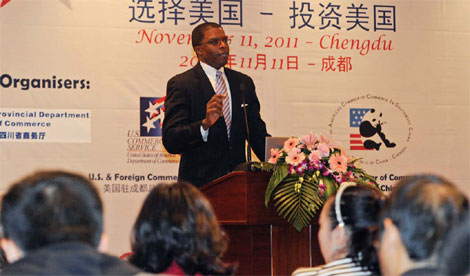US businessmen helping China devise strong investment model
Updated: 2011-12-02 07:34
By David Larviere (China Daily)
|
|||||||||
|
Seminars, such as this one in Chengdu, help Chinese investors understand the US market. [Provided to China Daily] |
Normally when business models are discussed, the image which comes to mind doesn't involve Chinese investment. But the result may turn out just as beautiful and captivating. On a recent information-gathering trip to Sweden, James Wang, deputy secretary-general of the China Industries Cooperation Association (CICA), was observing Chinese factories that Wang hopes will serve as a business model for US investors in 2012.
"Since several months of development went into how to structure a joint venture in Sweden, it made good sense to use this agreement as a jumping off point to the development of contractual arrangements between the parties in the US," says Florida businessman Joe Walsh, who has spent several weeks meeting with CICA officials. "We will parody these concepts and constructs within the US contracts."
Because the business plan was first deployed in Sweden, it is being referred to internally as "the Swedish model". The project involves several members of the CICA and entails the development of an industrial park in Sweden.
"The Swedish model reflects the basic ideas of developing an industrial economic park," Walsh says. "Although the particulars relating to green technology will not play within the documents, the construct of the financial aspects will be common to both developments. These documents will be meant as a guide to the finished energy park economic development plans."
Beijing-based CICA, with 1,800 members and several chapters throughout China, has been in existence since the 1930s.
"(China) has $1.3 trillion in exports (annually) and, to be honest, there's jealousy among other countries," Walsh says. "They are wise enough to know that, so they want to put plants in local areas. But here's the problem: They don't know how to build office buildings, warehouses and develop enterprise zones. They don't know how it works in America. They don't know about tax abatement. They want what they call 'services' addressed, such as legal, immigration, real estate, accounting and tax advice," Walsh explains, adding his US group would put together a consortium of professionals who can address all these needs.
Walsh, president and chief executive officer of the South Atlantic Regional Center, signed a Memorandum of Understanding with China in September to develop green technology in the US. "Our goal is to create these technology parks and make them applicable from town to town, much like a mall, with well-known anchor tenants. That's our model," Walsh says. "The Chinese are very interested in anything to do with greening." Walsh says pollution is a problem in Beijing and other large cities because so many Chinese move from the suburbs to the cities to work and buy cars in large numbers.
"They are going through their industrial age but the metrics are so much larger," Walsh says. "We had 100 million people when we (the US) went through ours (in the late 1800s)," he adds. China has about 1.3 billion people in comparison.
"Things are moving very fast and pollution is part of the relationship," Walsh notes. "I spoke to one businessman over there and he wants to make it a cleaner and better world, but it's not going to work unless there's a monetary motive. The motivation is there because in Beijing you can see (the thick pollution) in the air."
Walsh, who is returning to the States in mid-December for Christmas, estimates the project is in the second of about five stages at this point. The third stage will take place in January when Chinese investors start committing dollars. "After setting up the model, we'll have two levels of investment (direct investment and EB-5) with an initial $75 million-$100 million for Phase I, then another $200million-$250 million in two years," Walsh explains. "EB-5 is hot right now because it's a great way to help create US jobs."
The investment immigration initiative, known as EB-5, was enacted by Congress in 1990 as an employment-based immigrant visa for qualified foreigners seeking to invest in a business that will benefit the US economy and create or save at least 10 full-time jobs. Congress is considering adding to the program a real estate investment of at least $500,000 in designated areas.
The EB-5 program is slated to end in October 2012 but Walsh says "there has been a lot of chatter about making it a permanent thing." Currently, it is extended every two years. "It works so we need to make it that way right now," adds Walsh.
Kevin Wright, an attorney who works with Walsh and specializes in securing EB-5 designations, says, "EB-5 is not an immigration bill - it's a job creation enterprise. EB-5 is not selling out America."
Wright has a 100 percent success rate in securing Regional Center designations with about 35 all over the country.
Another appealing aspect of the model is it will incorporate university students. "There will be a quality technology school and development area on our properties for Chinese students and American students, an education process where they can get hands-on experience," Walsh says.
However, the students aren't the only intelligent ones involved. "The Chinese are very smart and shrewd, and they want to nip protectionism in the bud," says Walsh. "But they still need innovation from Western culture."
Walsh has ulterior motives. "I'm 58 years old, so I want to leave something for the next generation. I want to get it started and I think we can do something."












